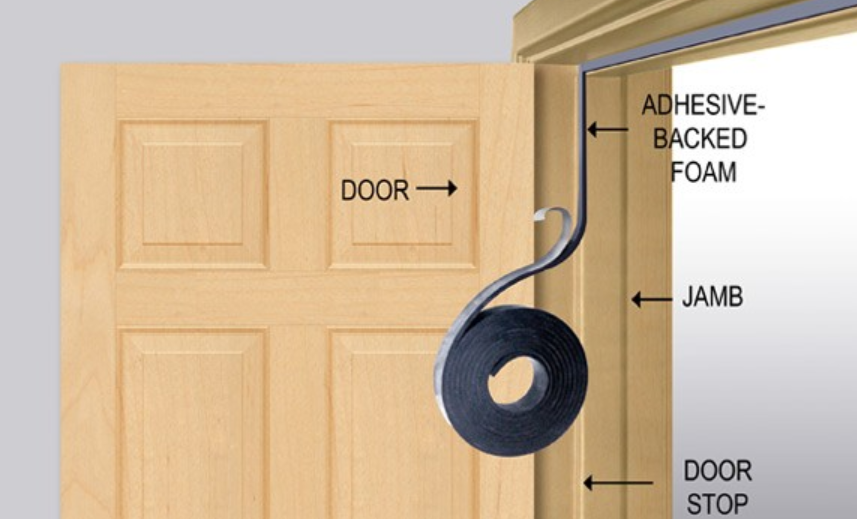Discover More
Draft proofing
Energy Efficiency Week 2021 / Friday
Level 3: Down with Drafts
If you turn up the thermostat and don’t feel the heat, there’s a problem. Old windows, worn doors, and poorly installed outlet covers are basically an open invitation for the frigid winter air to make its way indoors. Drafts can make us feel cold even when the room temperature should make it comfortable. To avoid feeling the draft and cut down on your heating bill we have advice on tracking drafts down and how to fix them.
 |
|
Old houses are notorious for drafts. However, even in a relatively new home there can be small defects which can cause drafts. If you notice any of the below, it might be an indication that you have a few defects that should be addressed.
- Difficulty opening and closing the window or door
- Cold rooms
- Drafts coming from the windows or doors
- Water damage or mould growing
- Fog or condensation between the glass panels on the window or door
- Badly sealed edges
- Noticeable gaps
Before you go around looking for leaks and drafts, it helps to know where to start. Common problem areas that often let cold air in include
- Electrical outlets
- Switch plates
- Door and window frames
- Skirting boards
- Fireplace dampers
- Attic hatches
- TV and phone and internet cables (where they enter the house)
- Vents and fans
How to Detect Leaks
- At night, shine a torch on the door and window frames. If the person on the other side sees light, you may have a leak.
- If you think doors are to blame, slip a piece of paper under the door. If you can pull the paper out without it dragging, you have a significant air leak.
- Hold a lit incense stick by windows, outlets, doors, and any of the other areas listed above. If smoke blows sideways, you likely have a leak.
- Rent or borrow a thermal leak detector. Some public libraries have a kit that you can borrow. This lets you measure the surface temperature of walls, doors, floorboards, and other surfaces. If the reading is a lot colder than the air, there’s a leak.
- Rent a thermal imaging camera. You can get these from some hardware stores. At night or during a cold period use the camera to highlight weak points around windows and doors. Any gaps, poorly insulated or poorly constructed details will show up blue. These are areas that require attention. If you do this from the outside, escaping heat will show up as orange or red.

How to Get Rid of Drafts
- For small cracks use a good quality silicone sealant. This is readily available in any good hardware/DIY store. Have a damp cloth ready, so you can wipe any excess product off after you’re applied it.
- For larger cracks and gaps, use spray foam. Avoid messy foam drips by finding a spray foam that comes with a straw. Spray foam can be messier to use than silicon so be careful when applying it. Have a damp cloth ready, so you can wipe any excess product off after you’re applied it.
- For doors, there are a range of draft excluders. Draft excluders prevent cold air from sneaking in under doors. It may not be as discreet as sealant, but it gets the job done. You can even make your own draft excluders out of old clothes and fabrics that you may have lying around – just search the internet for “how to make a draft excluder” for some handy instructions.
- Weather stripping on doors. The image below shows how to fit a draft strip. You can buy the strips at any good DIY store. They come in a variety of thicknesses and widths so measure of your door stop to help you choose the right product.

Windows and doors generally last up to 20 years, after which time, issues may begin to arise. Good quality wooden doors and windows can last longer if properly cared for
Signs you need to change or repair your windows and doors
- If they are not double or triple glazed.
- If they are leaky, resulting in drafts
- If they are in poor condition- wood starting to rot, if the PVC is badly discoloured
- If they are difficult to close
- If your energy bills are high- windows and doors may be a contributing factor but a whole house approach should be looked at.
- Condensation gathering on the inside of the window or in between double glazed panes.
Are there grants available for replacing windows and doors?
There are no individual grants for windows and doors unfortunately, however windows and doors can be replaced if you apply for the one stop shop grant which will tackle 3 major elements of the property.
Privacy Overview
| Cookie | Duration | Description |
|---|---|---|
| cookielawinfo-checbox-analytics | 11 months | This cookie is set by GDPR Cookie Consent plugin. The cookie is used to store the user consent for the cookies in the category "Analytics". |
| cookielawinfo-checbox-functional | 11 months | The cookie is set by GDPR cookie consent to record the user consent for the cookies in the category "Functional". |
| cookielawinfo-checbox-others | 11 months | This cookie is set by GDPR Cookie Consent plugin. The cookie is used to store the user consent for the cookies in the category "Other. |
| cookielawinfo-checkbox-necessary | 11 months | This cookie is set by GDPR Cookie Consent plugin. The cookies is used to store the user consent for the cookies in the category "Necessary". |
| cookielawinfo-checkbox-performance | 11 months | This cookie is set by GDPR Cookie Consent plugin. The cookie is used to store the user consent for the cookies in the category "Performance". |
| viewed_cookie_policy | 11 months | The cookie is set by the GDPR Cookie Consent plugin and is used to store whether or not user has consented to the use of cookies. It does not store any personal data. |




